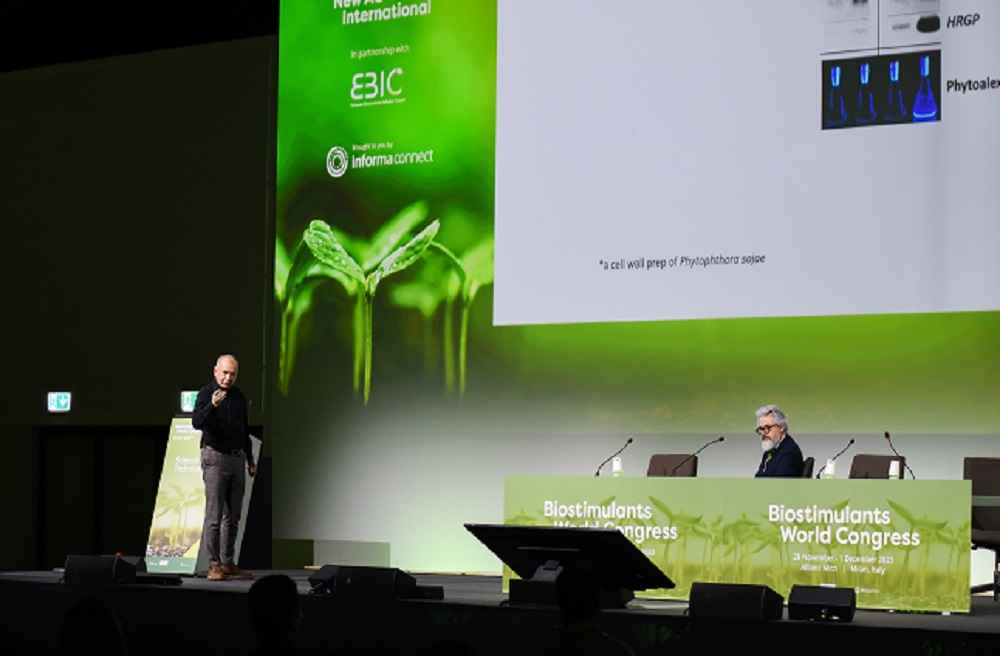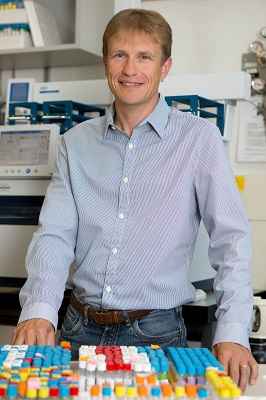
At the recent Biostimulants World Congress (BSWC), in Milan, Italy, keynote speeches were well received, delivered by leading experts in the biostimulants sector.
Day 1 of the congress saw Christophe Tebbe, Scientific Director, The Thünen Institute, Federal Research Institute for Rural Areas, Forestry and Fisheries, present ‘The cropland microbiome: Hidden services at threat’. He said that cropland microbiomes / soil microbiomes provide ecosystem services. “This means they have the potential to promote plant growth. They contribute to plant residue decomposition, they store in their biomass soil nutrients, which can later be released for plants. And, of course, they drive the biogeochemical cycling.”

Tebbe added that croplands without microbiomes would lose structure because microbiomes contribute to the soil structure by promoting aggregation. “And, of course, they mineralize pesticides and purify our water.”
Soil microbiomes are highly versatile. “They can utilize all the different different carbon sources. But the pathogens, they are specialized to specific plants. So, what we can do is diversify cropping systems using crop rotation, [and] explore intercropping to promote microbial diversity,” said Tebbe.
He added that soil microbiomes facilitate transport and provision of plant nutrients. “And that means we need to talk to crop breeders, that we need to develop crops with good performance under nutrient limiting conditions.” And to diversify cropping systems with new or old species and reduce fertilizers and pesticides.
“And finally, the earthworm comes into play,” said Tebbe. Soil microbiomes are highly connected communities in aggregates. “And microbiomes love this collaboration and that can be supported with earthworms.” Tebbe added we need to promote non tillage soil management.
“The take home message is soil microbiomes are not randomized mixtures of different bacteria and taxa, but they are highly organized social biological structures. And using and managing microbiomes, in my view, is a key for transformation to more sustainable agriculture.”
African food systems under change
Johan Six, Chair of the Sustainable Agroecosystems Group, ETH-Zurich, presented his keynote ‘Resilient food systems under global change in Sub-Saharan Africa’. The presentation brought a perspective of how biostimulants are crossing borders and are now impacting many different geographies, include sub-Saharan Africa.
Six noted that in African rural areas, there are small farms with high variability. That is, within a very small distance, there are very good soils and very poor soils. “That comes then to how we manage that and how do we get that circular bioeconomy in, and how can we maybe put in these biostimulants that we are talking about? We are talking about a very differentiated landscape with pockets of very good soils but also lots of pockets of very poor soils on the same farm.”
Six said that with these smallholder farms, it is very difficult to consider the use of fertilizers, biostimulants or input for that matter. “We have to realize that most of the people, these smallholders, are basically making between $10 and $40 per month. That is their incomes. So, it’s easy to say that they should buy more inputs, but if you live on an income of this much, it becomes obviously very difficult, especially if you’re a female farmer. And we know that farming is happening mostly by females who make less than their male counterparts.”

Six noted that when it comes to considering the use of biostimulants on these small scale farms, the final judge is the field. “We have to see first of all what it does in the field. I don’t think it’s magic, but I do think adding it together with other soil amendments and also with better seeds is definitely the way to go.”
He stressed again the variablity in soils. “Variation in soil fertility conditions affects agronomic and economic viability, and risks need to be assessed when using biostimulants/fertilizers, especially for smallholder farmerswith limited resources,” Six said. “So that’s where the supply chain has to become more efficient, and do it together with these other elements that we need.”
He also said private sector investment is necessary, “but again let’s not have negatively impacted these smallholder farmers because otherwise, we’re going to miss the ball altogether.
“We have a lot of subsistence farmers, these smallholder farmers, but where I think the biostimulants and biofertilizers can help is by helping some of them, together with all the other elements that I’m talking about, to bring them up into emerging small and medicum sized commercial farms,” he added. “We have to really have a systems perspective of how can we get them out of that smallholder systems farming into something that is commercial and then there is where the biostimulants and the biofertilizers can work.”
Salt stress and biostimulants
In the afternoon of day 1, keynote speaker Albino Maggio, Professor, Department of Agricultural Science, University of Napoli Federico I, spoke on ‘Revisiting crop salt stress tolerance and the function of biostimulants’.
Maggio noted that salinity is one of the most important environmental stressors, and that soil salinity affects nearly 50 percent of all irrigated land in the world.
“Salinity affects plants from a biochemical perspective, physiological changes, morphological changes and, overall, in biomass and grain yield,” he said.
“A biostimulant is a multi-component product. They have different effects, and they can have a huge effect on a regulatory machine that is quite complex and quite complicated.”

When it comes to the role of biostimulants and salt stress tolerance, what Maggio says they know so far is that the role of biostimulants as a growth enhancer has been established. “We don’t know exactly how much for improved yield, but there is clear evidence that they have an effect. And products are available on the market,” he noted. “But biostimulants as a specific stress protectant – many other growth enhancers, they also show some protection versus other stresses, but that’s something different to understand how biostimulants are interacting with the mechanism that protect plants from the stress.”
Maggio concluded his keynote by reiterating that biostimulants are an important turning point in crop stress protection, including salt stress.
“We have learned a lot from research on plant salt stress adaptation. Biostimulants have a greater potential compared to other technologies,” he said. “I think that biostimulants can help us in understanding the mechanism of salt stress adapation that are not clear yet. And I think what is forward looking is a systematic approach to understand the mechanism of action of biostimulants in a systematic way. And only with this path I see how we can fully exploit the potential value of eco-compatible molecules.”
Biostimulants and precision agriculture
On day 2 of the BSWC, Davide Cammarano, Professor, Department of Agroecology, Climate and Water at Aarhus University, opened the day with his keynote ‘Combining plant biostimulants with precision agriculture’.
Cammarano began by saying innovation flourishes when there are big problems to solve, citing the often-quoted estimates for future food requirements to feed a growing global population.
“Therefore, we need several game changing technologies if we want to keep up with production and sustainability of this product at a global scale,” he noted. “But while nowadays there is this big hype about agriculture 4.0 digital ag or rediscovery of precision agriculture, agriculture is still one of the least digitized sectors among the many commercial sectors. And I think it’s because we need different experts with different skills and with a system-based thinking.”
The International Society of Precision Agriculture defines precision agriculture as “a management strategy that takes account of temporal and spatial variability to improve sustainability of agricultural production.”

“I think one of the keys nowadays is, how can we employ digital technologies like precision agriculture to optimize inputs in order to optimize production by minimizing environmental impacts? Precision agriculture deals exactly with that,” said Cammarano. “For any agronomic management, no matter if we’re talking about fertilizer, planting, planting density or irrigation, the main steps in precision agriculture can be summarized into three main areas: we need to assess the field variability, we need to manage this variability, and we need to evaluate the variability, and keep repeating this loop. This is the key for combining biostimulants with precision agriculture.”
Cammarano said the combination of precision agriculture and biostimulant application is a rather novel field and still in its evolution. Few studies are available, but he stressed it can be a scientific area with a lot of potential.
“In considering the adoption of precision agriculture within the field of biostimulants, we need to think that yield is the result of many dynamic interactions in both space and time,” he said. “Think about weather, the soil types, fertility, the genotypes, the management and so on. In order to design future experiments, we need to go back to the basics, so is it sensor based, map based? How do we want to combine the two, and how do we do that? We need to account for the temporal interactions, for example, stresses, which will improve the ability to use precision agriculture.”
Enhancing plant defense
Uwe Conrath, Professor, Plant Physiology Department Aachen Biology and Biotechnology (ABBt), RWTH Aachen University, delivered the keynote presentation on day 2, entitled ‘Priming plants for enhanced defense’, and elucidated on the concept of plant memory and disease resistance.
Upon infection with necrotizing pathogens, many plants develop an enhanced resistance to further pathogen attack also in the uninoculated organs. This type of enhanced resistance is referred to as systemic acquired resistance (SAR). In the SAR state, plants are primed (sensitized) to more quickly and more effectively activate defense responses the second time they encounter pathogen attack. Since SAR depends on the ability to access past experience, acquired disease resistance is a paradigm for the existence of a form of “plant memory”.
Conrath noted that systemic acquired resistance (SAR) is not a new phenomenon – indeed, it was described by two French botanists at the beginning of the 20th century. “Since then, plant biologists wondered about what’s going on in the systemic tissue, what makes the plant systemically resistant?” explained Conrath.
Work by scientists in the early 1990s reported that of an infection of a local leaf with a pathogen, systemic signalling gets induced. And this, noted Conrath, leads to the systemic accumulation throughout the plant of salicylic acid, the small phenolic molecule. Salicylic acid then causes the accumulation of antimicrobial SAR proteins, and many of these proteins are pathogenesis-related (PR) proteins, and many PR proteins have antimicrobial activity.

“And then people thought, well, issue solved. This is how SAR works. The systemic accumulation of the antimicrobial proteins is responsible for the enhanced defense capacity of the plant and the resistance seen in the systemic tissue. This then leads to systemic immunity or systemic acquired resistance,” said Conrath. “Well, this whole concept was challenged, and the issue was opened again – how does a plant express systemic acquired disease resistance?”
To help him understand the science, Conrath worked as a postdoc in the U.S. to learn everything he could about SAR. “And then I went back to Germany and followed up this series of experiments that I did before.” As part of his keynote, Conrath laid out his experiments and findings, and other research that focused on molecular mechanisms of defense priming.
He noted that two years ago, he and others founded and launched AgPrime, a company that has in-depth experience in plant molecular biology, biochemistry, biotechnology and pathology. “We provide multiple services for evaluating plant performance in stress conditions and develop innovative concepts for effective and sustainable crop protection, particularly by strengthening the plant immune system from within,” notes the company’s website.
“We want to help further translate priming to the field,” said Conrath. “What we do is basically we use extracts that we get from our customers, fractions, molecules or organisms. We check formulations, and develop formulations with our partners. We look for synergy with conventional products, also with synthetic fungicides or pesticides in general.”
The company identifies plant health/abiotic stress resilience-promoting activities and synergistic effects; perform mode-of-action analysis; and evalutes active ingredient/product performance in various conditions.
“We also developed screening tools, depending on the needs of the customers. And we also have identified our own priming compounds, agents and beneficial PGPRs,” said Conrath.
Importance of soil health
Day 3 saw Mirjam Pulleman, Senior Soil Scientist, CIAT & Wageningen University, deliver her keynote speech ‘The soil health metaphor: does a focus on soil health help us to create more sustainable food production systems?’.
Pulleman began by saying that anthropogenic climate change has slowed down global agricultural productivity growth, and that this is affecting especially countries in the tropics. “But we are also dealing with soil degradation,” she noted, citing 10 soil threats, including soil erosion, loss of organic carbon, nutrient imbalances, salinization, soil sealing, loss of biodiversity in the soil, contaminants, acidification, compaction and water logging.
“Very importantly, this threatens food security and ecosystems, and the services that those ecosystems provide,” she said. “And smallholder farmers in theh global south are disproportionately affected by this.”

Pulleman suggests the need for sustainable intensification, comprised of three prinicples: increasing production per unit of land, capital or labour; conservation and harnessing of ecosystem services, delivered by healthy soils and biodiversity; and, resilience to shocks and stresses, including climate change.
“One of the initiatives that I’m involved in and working on currently is excellence in agronomy for sustainable intensification and climate adaptation,” she said. “This is a CGIAR-led initiative that was launched in 2020 and that will continue until 2030, with the aim to support millions of smallholder farming households through collaboration with partners on the ground, as well as universities, to achieve agronomic gain in prioritized farming systems. And this will be done by increasing productivity and also product quality per unit of input, by increasing resource use efficiency, which includes nutrients, water and labour, and by improving soil health and climate adaptation.”
Pulleman’s keynote revolved around the definition of soil health, how soil health is measured, and the role of biofertilizers and biostimulants in the context of smallholer farmers in the tropics.
To the latter point, in her work, Pulleman said she has been thinking about what role biofertilizers and biostimulants play in the context of smallholder farms in the tropics. “From my experience…in Latin America, I do see that there is a very strong interest of farmers, also smallholder farmers, in biostimulants and biofertilizers,” she noted. “This is really interesting because it has also created a sort of awareness among farmers how important the biology is in the system, and they really start looking at the soil in a different way. But what do they do? Some of them buy commercial biostimulants, with mixed success. But there is a very strong promotion, especially in commercial crops like coffee and cocoa, to support farmers to make their own biofertilizers.”
Pulleman presented several takeaways from the work she is involved with. For instance, restoring/enhancing soil health is key for sustainable intensification and regenerative agriculture in theh global south, while reducing vulnerability of smallholder farmers to climate change; a flexible framwork is proposed that can be used to target, monitor and adapt soil health interventions with relevant stakeholders; development of biological soil health indicators and assessment methods requires more research, given the key role of soil biology for soil health/functions; high fertilizer costs, attention for soil health have led to the promotion of “smallholder-friendly” “biofertilizers”, especially in Latin America, but scientific evidence and mechanistic understanding is lacking; and, robust, hypothesis based, experimental research is needed to develop targeted, proven methods, alongside feasility studies and development of rural business models for biofertilizers and biostimulants that can be made from local residue streams.